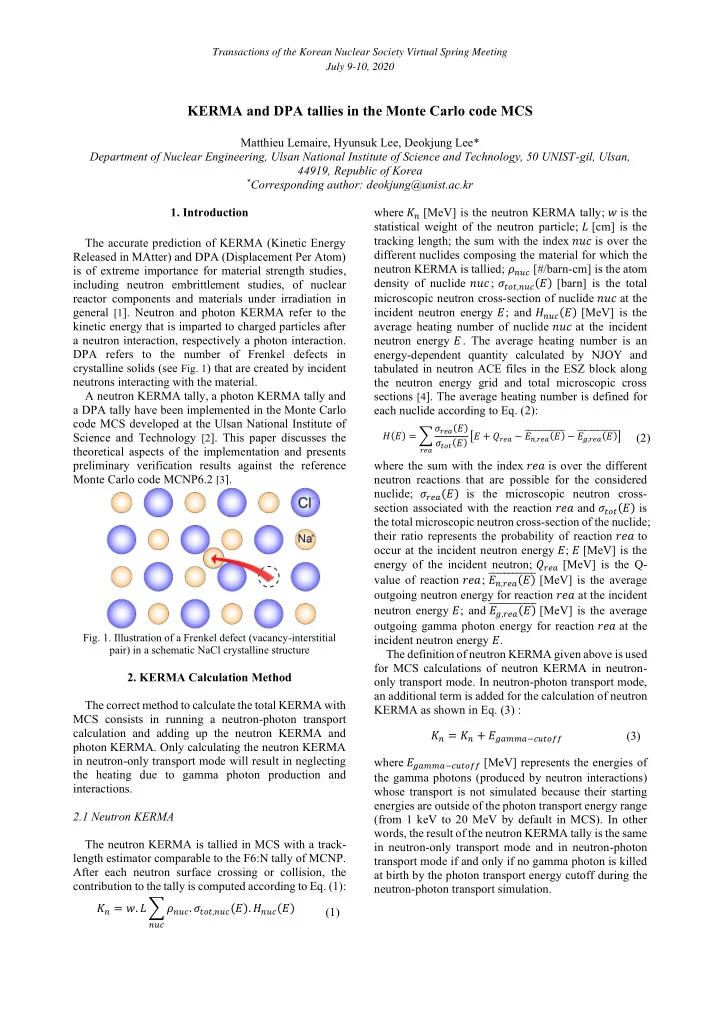

Transactions of the Korean Nuclear Society Virtual Spring Meeting July 9-10, 2020 KERMA and DPA tallies in the Monte Carlo code MCS Matthieu Lemaire, Hyunsuk Lee, Deokjung Lee* Department of Nuclear Engineering, Ulsan National Institute of Science and Technology, 50 UNIST-gil, Ulsan, 44919, Republic of Korea * Corresponding author: deokjung@unist.ac.kr 1. Introduction where 𝐿 𝑜 [MeV] is the neutron KERMA tally; 𝑥 is the statistical weight of the neutron particle; 𝑀 [cm] is the tracking length; the sum with the index 𝑜𝑣𝑑 is over the The accurate prediction of KERMA (Kinetic Energy different nuclides composing the material for which the Released in MAtter) and DPA (Displacement Per Atom) neutron KERMA is tallied; 𝜍 𝑜𝑣𝑑 [#/barn-cm] is the atom is of extreme importance for material strength studies, density of nuclide 𝑜𝑣𝑑 ; 𝜏 𝑢𝑝𝑢,𝑜𝑣𝑑 (𝐹) [barn] is the total including neutron embrittlement studies, of nuclear microscopic neutron cross-section of nuclide 𝑜𝑣𝑑 at the reactor components and materials under irradiation in general [1 ]. Neutron and photon KERMA refer to the incident neutron energy 𝐹 ; and 𝐼 𝑜𝑣𝑑 (𝐹) [MeV] is the kinetic energy that is imparted to charged particles after average heating number of nuclide 𝑜𝑣𝑑 at the incident a neutron interaction, respectively a photon interaction. neutron energy 𝐹 . The average heating number is an DPA refers to the number of Frenkel defects in energy-dependent quantity calculated by NJOY and crystalline solids (see Fig. 1 ) that are created by incident tabulated in neutron ACE files in the ESZ block along neutrons interacting with the material. the neutron energy grid and total microscopic cross A neutron KERMA tally, a photon KERMA tally and sections [4 ]. The average heating number is defined for a DPA tally have been implemented in the Monte Carlo each nuclide according to Eq. (2): code MCS developed at the Ulsan National Institute of 𝐼(𝐹) = ∑ 𝜏 𝑠𝑓𝑏 (𝐹) ̅̅̅̅̅̅̅̅̅̅̅̅ − 𝐹 ,𝑠𝑓𝑏 (𝐹) ̅̅̅̅̅̅̅̅̅̅̅̅] Science and Technology [2 ]. This paper discusses the 𝜏 𝑢𝑝𝑢 (𝐹) [𝐹 + 𝑅 𝑠𝑓𝑏 − 𝐹 𝑜,𝑠𝑓𝑏 (𝐹) (2) theoretical aspects of the implementation and presents 𝑠𝑓𝑏 preliminary verification results against the reference where the sum with the index 𝑠𝑓𝑏 is over the different Monte Carlo code MCNP6.2 [3 ]. neutron reactions that are possible for the considered nuclide; 𝜏 𝑠𝑓𝑏 (𝐹) is the microscopic neutron cross- section associated with the reaction 𝑠𝑓𝑏 and 𝜏 𝑢𝑝𝑢 (𝐹) is the total microscopic neutron cross-section of the nuclide; their ratio represents the probability of reaction 𝑠𝑓𝑏 to occur at the incident neutron energy 𝐹 ; 𝐹 [MeV] is the energy of the incident neutron; 𝑅 𝑠𝑓𝑏 [MeV] is the Q- ̅̅̅̅̅̅̅̅̅̅̅̅ [MeV] is the average value of reaction 𝑠𝑓𝑏 ; 𝐹 𝑜,𝑠𝑓𝑏 (𝐹) outgoing neutron energy for reaction 𝑠𝑓𝑏 at the incident ̅̅̅̅̅̅̅̅̅̅̅̅ [MeV] is the average neutron energy 𝐹 ; and 𝐹 ,𝑠𝑓𝑏 (𝐹) outgoing gamma photon energy for reaction 𝑠𝑓𝑏 at the Fig. 1. Illustration of a Frenkel defect (vacancy-interstitial incident neutron energy 𝐹 . pair) in a schematic NaCl crystalline structure The definition of neutron KERMA given above is used for MCS calculations of neutron KERMA in neutron- 2. KERMA Calculation Method only transport mode. In neutron-photon transport mode, an additional term is added for the calculation of neutron The correct method to calculate the total KERMA with KERMA as shown in Eq. (3) : MCS consists in running a neutron-photon transport calculation and adding up the neutron KERMA and 𝐿 𝑜 = 𝐿 𝑜 + 𝐹 𝑏𝑛𝑛𝑏−𝑑𝑣𝑢𝑝𝑔𝑔 (3) photon KERMA. Only calculating the neutron KERMA in neutron-only transport mode will result in neglecting where 𝐹 𝑏𝑛𝑛𝑏−𝑑𝑣𝑢𝑝𝑔𝑔 [MeV] represents the energies of the heating due to gamma photon production and the gamma photons (produced by neutron interactions) interactions. whose transport is not simulated because their starting energies are outside of the photon transport energy range 2.1 Neutron KERMA (from 1 keV to 20 MeV by default in MCS). In other words, the result of the neutron KERMA tally is the same The neutron KERMA is tallied in MCS with a track- in neutron-only transport mode and in neutron-photon length estimator comparable to the F6:N tally of MCNP. transport mode if and only if no gamma photon is killed After each neutron surface crossing or collision, the at birth by the photon transport energy cutoff during the contribution to the tally is computed according to Eq. (1): neutron-photon transport simulation. 𝐿 𝑜 = 𝑥. 𝑀 ∑ 𝜍 𝑜𝑣𝑑 . 𝜏 𝑢𝑝𝑢,𝑜𝑣𝑑 (𝐹). 𝐼 𝑜𝑣𝑑 (𝐹) (1) 𝑜𝑣𝑑
Recommend
More recommend